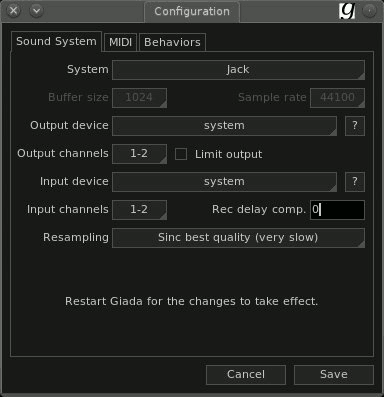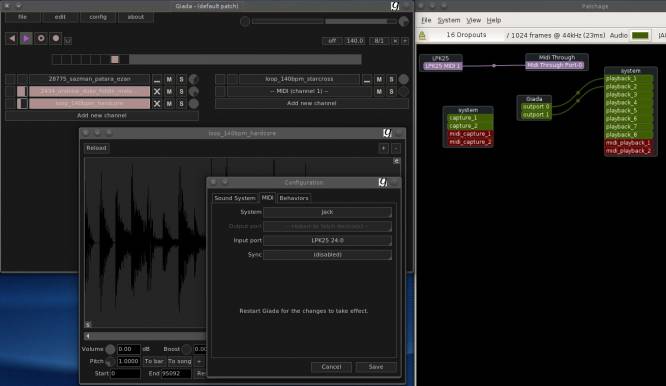Giada Loop Machine
Giada is a loop machine designed for live performance and loop-based improv. It can trigger samples in a variety of ways, allowing you to build stacks of sounds into unique compositions.
Strengths [Weaknesses]
Unique
Giada has a unique vision of how samples and sounds can be stitched together. Its dedication to being a great and fully-featured loop machine means you can be creative and inventive.
Weaknesses [Strengths]
Loopy
Loop-based composition is a niche, and that's the main paradigm in Giada.
Install
To install Giada, visit http://studioware.org and install these dependencies first:
rtmidi(located instudioware.org/packages/slackware$ARCH-X.Y/audio/system/)rtaudio(located instudioware.org/packages/slackware$ARCH-X.Y/audio/system/)
Additionally, upgrade fltk for compatibility
fltk(located instudioware.org/packages/slackware$ARCH-X.Y/audio/libraries/)
Once these have been installed and updated, install Giada.
Usage
Giada can be used with or without JACK. If all you want to do is play music loops with Giada as a self-contained application, there is no need to use JACK, but if you want to integrate it with other applications, effects, and instruments, then JACK is your best bet.
If you do use Giada with JACK, then Giada will warn you upon first launch that your sound card is not configured correctly. This is not quite accurate; actually, your sound card is probably fine, but Giada cannot find it because it is presently occupied by JACK.
To fix this, go to the config menue at the top of the Giada window and set the audio system to Jack. Relaunch Giada for the new setting to be loaded.
Giada has different channels, each of which can play different loops. To add a loop, click a slot in a channel and load in a file.
Any given Giada project has several Play buttons; the global playback starts the timebase (the main sequencer in Giada terminology) for all other loops. For instance, the master loop time is four beats, and the default tempo of 120 beats per minute. This means that every two seconds, the master loop starts over. If the loops loaded into your project are 120 BPM, then pressing Play on the project and Play on any loop will cause a loop to play for one measure, and then stop at the point of rotation. To loop something endlessly, click the loop setting button (the _ button before the M and S buttons to the right of each loop) and set the loop playback option.
If your loops are not 120 BPM, then the project will loop but the individual loop will continue playing (or it will have already ended); if it is set to loop endlessly, then it will continue to loop at an offset from the project time. If the loop is syncopated to a specific rhythm, this could be strange, so you can adjust the project BPM in the settings in the top right of the Giada window. If the loop is not syncopated (for instance, if it's just a drone or a sound effect), or you happen to like offset rhythms, then you can keep your settings as they are and continue to experiment.
Sessions
Giada is able to produce three kinds of files: patches, projects and samples.
Patch
A patch is a text-based .gptc file in which volumes, samples, statuses and configurations are saved. Same a patch file if you are using samples from your local collection (in other words, you have not performed sample editing within Giada). Patch files expect samples to be located in reliable locations; don't save a patch file, then reorganise all of your assets, and expect Giada to know how to know how to find all the things listed in your patch file.
Project
If you have performed destructive editing on samples within Giada, then you must save as a project (for the same reason that Audacity requires projects; the application must be able to track all the bits and pieces you have asked it to create). A project is a .gprj directory with all of your samples stored within it, plus a patch file that maps everything relative to the project directory. In other words, this makes your Giada project mostly self-contained.
Samples
Export individual samples as wav files.
Documentation
Mhile the framework of Giada is inflexibly loop-driven, the application is fully-featured. Loops can be edited, effects applied, events triggered.
For full documentation, see http://giadamusic.com/documentation.
Assets
The site http://freesound.org features, among other things, loops under a Creative Commons license.

